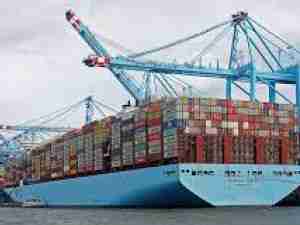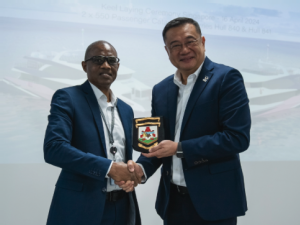ZIM's Sustainability Report does not differ much from the ones by MSC and Hapag-Lloyd; the main difference is that ZIM provides more data on fuel consumption and CO2, SOx, and NOx emissions—that explains the additional half-star we have given to ZIM. As we have insisted on the previous reviews, data is critical on any reporting; one is left with narratives without it. Let's see now some of the weaknesses and strengths of ZIM's environmental reporting.
Contrary to other liners, ZIM does not boast of impacting the 17 Sustainable Development Goals (SDGs). ZIM considers that its actions impact SDGs 3, 4, 8, 9, 10, 12, 14, 17. That is good since that means that they dug deeper into the positive and negative impacts of the company. However, they did not dig deep enough: ZIM does not explain how its actions are impacting each of the SDGs, and even better, it would have been that they mention the specific targets (of the total of 169 targets) on those eight SDGs that the company is impacting. That would not have left the labor incomplete. By the way, we are not expecting that any shipping company goes as deep as mentioning indicators (231 in total) because that would reflect that the company is not telling the truth since the majority of indicators apply to the national or regional levels, but no the companies' one. We try to emphasize that the liners must understand the SDGs because it is flatly wrong to include all the 17 icons as most do, and it is not good enough to have only a look at them and check which one considers that is impacted and which not.
One of the key challenges that liners have for the future is incorporating their suppliers into their Sustainability Reports—ZIM is not an exception. For instance, regarding GHG emissions, companies from other industries have shockingly found that their Scope 3 emissions (mainly suppliers) could be as high as their Scope 1 emissions (direct emissions by the company). The shipping companies are still in their infancy about the inclusion of suppliers. ZIM states: "In 2019 we created a sustainability clause to be added to all our new and renewed procurement contracts; both with vendors and suppliers. Under the new contracts, suppliers and vendors commit to complying with ZIM's standards relating to health, safety and the environment. In the future, we plan to include these in existing contracts as well." Of course, even the general inclusion of commitment to "complying with ZIM's standards relating to health, safety and the environment," would only be rhetorical if ZIM does not monitor and evaluate their suppliers. That is the real challenge of taking into account suppliers' environmental impact: a real inclusion would imply monitoring and evaluating at least the largest suppliers to the company.
Concerning the compliance of IMO 2020, we praise the decision by ZIM: without expressing its name, it followed what is called the precautionary principle in environmental laws and regulations: "Amid the controversy over Exhaust Gas Cleaning Systems (EGCS) in which scrubbers' wash water is discharged back into the ocean (with a possible transfer of pollution from air to sea, which could be harmful and unsafe for the ocean environment), ZIM's general policy is to use compliant fuel. ZIM prefers to meet the 2020 global sulphur limits by using primarily compliant low sulphur fuels rather than using heavy fuel oils in combination with a scrubber (...) All ships in our fleet, both owned and chartered, use low sulphur fuels to reduce the environmental impact of their main engines." Most liners retrofitted with scrubbers a share of their fleet (not the old ones) based on economic reasons; ZIM, on the contrary, followed that precautionary principle, which has become paramount when science has not concluded that some actions impact the environment, but the possibility remains open.
Then ZIM adds: "On certain routes and services, we practice Super-Slow Steaming to enable substantial fuel savings resulting in significantly reduced CO2 and NOx emissions." We have found similar claims in other Sustainability Reports, but no data is provided: "On certain routes and services," could mean on 5%, 15%, 30%, or practically any other number, and by super-slow steaming, we assume that is the conventional range of fewer than 18 knots per hour, but it would have been better if ZIM had provided that number.
Most companies make reference to the use of digital technologies to optimize the efficiency of their fleets. ZIM provides very comprehensive coverage of its utilization of digital technologies, which, among other benefits, has important environmental repercussions:
"Our innovative Global Operations Center (GOC) makes our operational information available at any time, for every ship on a specific line. It enables the receipt of a full update on a ship's status in real time followed by a quick, precise response. The GOC receives complete real-time data relevant to operating a ship at sea and in port, including cruising speed, fuel consumption, weather, currents, wave height, waiting time outside the port, cargo operation in port, as well as many other operational analytics that help to optimize the ships' operations and reduce bunker consumption, thus reducing our CO2 footprint. Our GOC is the heart of the Company's operations, bringing together all the activities of ships at sea and in port. Its strict control, transparency, availability, and ongoing monitoring greatly contribute to improving the Company's business results."
And it continues: "The GOC's main functions are: Providing a global picture of the entire fleet operated by ZIM and its partners; Enabling operational control of ZIM-operated vessels; Enabling management and operational decision making from a global perspective; Monitoring ship cruising speed and trim; Monitoring and keeping ships on schedule, in accordance with weather constraints; Monitoring and reducing fuel consumption; Analyzing terminal operations; Optimizing cargo operations in port, such as reducing waiting time in port; Monitoring and improving predefined KPIs; Developing and maintaining decision-support systems; Managing the Company's preparedness for routine and emergency situations."
ZIM, as most liners, make claims about the second life onshore that many containers reach once it comes the time to replace them: "Another way in which we try to reduce our ecological footprint and encourage recycling is to extend the lives of our containers by offering a large inventory of used shipping containers for sale or donation at the end of use. After we retire containers from our fleet, they begin new careers all over the world, providing outstanding solutions for diverse storage needs. Some are even refitted and redesigned as residences, offices, classrooms, and other spaces." Wow! All that sounds great. But then in the section about "Giving back to the community," one finds the numbers: "During 2019, ZIM donated ten of our outdated and unusable containers to benefit various communities around the world." Please, if next year ZIM will donate again ten or even twenty or thirty, better avoid that claim altogether. This shows why data matters. Most liners, for instance, claim that they have retrofitted ships with better propellers, rudders, ballast water systems, or plenty of other innovations, but if then they tell us that it was for three or four ships when their fleets are "a bit" bigger, those claims lose all their weight.
We left, for the end, the most relevant part of the environmental reporting by ZIM (the reason why we give it 4 stars out of five rather than the 3.5 stars we gave to MSC and Hapag-Lloyd). Here are the numbers:
ZIM provides only those numbers without much explanation (they also provide for NOx and SOx). Besides, the lack of information about number of TEUs by dry and reefer containers does not allow to retrace the numbers, but, of course, one cannot doubt the numbers' veracity, mainly that the data was reviewed by the Standards Institute of Israel. The large drop in fuel consumption from 2018 to 2019 (almost 30%) is not explained by ZIM because one can assume that only part of that reduction was due to the following reason: "We strive to reduce fuel consumption and emissions due to inland cargo transportation by selecting rail transportation whenever available. In 2019 we entered into a new agreement for inland rail transportation in the US. This agreement stipulated direct connection between two railroad companies, allowing the detaching and reconnecting of container-bearing flatbed rail cars, thus eliminating the need for unloading, transfer by road and reloading." Why can that reason not be the main explanation? ZIM is primarily a shipping company; any saving due to truck haulage replacement by rail freight can be only a secondary reason.
There is no mention in the report of Scope 2 emissions. Although they tend to be tiny for shipping companies, it would have been useful to include them for its headquarters and main offices worldwide. Regarding Scope 3, we have already commented that the maritime industry lags well behind the company leaders in other industries.
One severe weakness of ZIM's report is the lack of GHG emissions reduction goals for the medium and long term—the company does not say anything beyond 2025. Such lack of commitment is contradictory to ZIM's recent decision to join the Getting to Zero Coalition.
While it is good that ZIM provides fuel and emissions data, the report does not include data about waste or other environmental indicators. The report by COSCO with only 35 pages released more data than ZIM 82 pages.
In summary, ZIM certainly covers most of the sections one would expect on environmental reporting, but often the treatment is light, providing barely the most basic information, and as we have seen, there are important gaps. Why are we giving 4 stars out of 5 to ZIM then? Since this is the first year we are writing these independent reviews, we have tried to be less drastic as we expect to be next year: ZIM has provided a full report and has released the most critical data; hence, we consider that that extra half-star over MSC and Hapag-Lloyd is well deserved.










